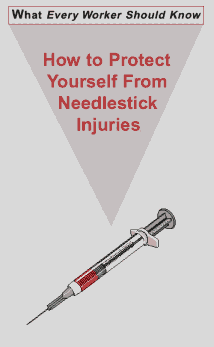
|

What Every
Worker Should Know
How to
Protect Yourself From Needlestick Injuries
DHHS
(NIOSH) Publication No. 2000-135 |
What infections can be caused by needlestick
injuries?
Needlestick injuries can expose workers to a
number of bloodborne pathogens that can cause serious or fatal infections.
The pathogens that pose the most serious health risks are
- Hepatitis B virus
(HBV)
- Hepatitis C virus
(HCV)
- Human immunodeficiency
virus (HIV) -- the virus that causes AIDS
HBV vaccination is
recommended for all health care workers (unless they are immune because of
previous exposure). HBV vaccine has proved highly effective in preventing
infection in workers exposed to HBV. However, no vaccine exists to prevent
HCV or HIV infection.
| Preventing
needlestick injuries is the best way to protect yourself from these
infections. |
Who is at risk of
needlestick injury?
Any worker who may come in contact
with needles is at risk, including nursing staff, lab workers, doctors,
and housekeepers.
How common are
needlestick injuries among health care workers?
Estimates indicate that 600,000 to 800,000 needlestick injures
occur each year. Unfortunately, about half of these injuries are not
reported. Always report needlestick injuries to your employer to ensure
that you receive appropriate followup care.
What kinds of needles
usually cause needlestick injuries?
- Hypodermic
needles
- Blood collection
needles
- Suture needles
- Needles used in IV
delivery systems
| Needlestick injuries can lead to serious or
fatal infections. Health care workers who use or may be exposed to
needles are at increased risk of needlestick injury. All workers who
are at risk should take steps to protect themselves from this
significant health hazard. |
Do certain work
practices increase the risk of needlestick injury?
Yes. Past studies have shown that needlestick injuries are often
associated with these activities:
- Recapping
needles
- Transferring a body
fluid between containers
- Failing to dispose of
used needles properly in puncture-resistant sharps containers
How can I protect
myself from needlestick injuries?
- Avoid the use of needles where
safe and effective alternatives are available.
- Help your employer
select and evaluate devices with safety features that reduce the risk of
needlestick injury.
- Use devices with
safety features provided by your employer.
- Avoid recapping
needles.
- Plan for safe handling
and disposal of needles before using them.
- Promptly dispose of
used needles in appropriate sharps disposal containers.
- Report all needlestick
and sharps-related injuries promptly to ensure that you receive
appropriate followup care.
- Tell your employer
about any needlestick hazards you observe.
- Participate in
training related to infection prevention.
- Get a hepatitis B
vaccination.
|
For
additional information, see NIOSH Alert:
Preventing Needlestick Injuries in Health Care Settings [DHHS
(NIOSH) Publication No. 2000-108]. Single copies of the Alert are
available from the following: NIOSH-Publications
Dissemination
4676 Columbia Parkway
Cincinnati, OH
45226-1998
1-800-35-NIOSH
(1-800-356-4674)
Fax: 513-355-8573
E-mail:
pubstaft@cdc.gov
|
DHHS (NIOSH)
Publication No. 2000-135
To receive other information about
occupational safety and health problems, call 1-800-35-NIOSH
(1-800-356-4674), or visit the NIOSH Home Page on the World Wide Web at http://www.cdc.gov/niosh/homepage.html
This page
was last updated on September 13, 2000
 
| 